
Mallotus is a genus of the spurge family Euphorbiaceae first described as a genus in 1790. Two species are found in tropical Africa and Madagascar. All the other species are found in East Asia, the Indian Subcontinent, Southeast Asia, eastern Australia, and certain islands of the western Pacific. The genus has about 150 species of dioecious trees or shrubs.
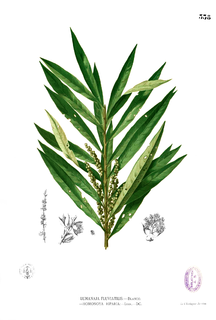
Homonoia is a plant genus of the family Euphorbiaceae first described in 1790. These are rheophytes and usually found in groups at riverbanks in India, southern China, Southeast Asia, and New Guinea.
- Homonoia intermediaHaines - India
- Homonoia retusa Müll.Arg. - India
- Homonoia riparia Lour. - Guangxi, Guizhou, Hainan, Sichuan, Taiwan, Yunnan, Cambodia, India, Assam, Bhutan, Sri Lanka, Borneo, Java, Lesser Sunda Islands, Sulawesi, Sumatra, Maluku, Laos, Malaysia, Myanmar, Philippines, Thailand, Vietnam, New Guinea, Andaman & Nicobar Islands
Spathiostemon is a genus of trees in the Euphorbiaceae family. It is native to the Bismarck Archipelago, New Guinea, Wallacea and Southeast Asia. The trees grow between 10 and 20m tall, often in secondary forest. The wood is sometimes used.

Alchorneopsis is a genus of flowering plants in the family Euphorbiaceae first described as a genus in 1865. It is native to Central America, the Greater Antilles, and northern South America.
- Alchorneopsis floribunda(Benth.) Müll.Arg. - Costa Rica, Honduras, Panama, Puerto Rico, Dominican Republic, 3 Guianas, Colombia, Venezuela, Ecuador, Peru, NW Brazil
- Alchorneopsis portoricensisUrb. - Puerto Rico

Doryxylon is a monotypic plant genus in the family Euphorbiaceae first described as a genus in 1857. The sole species is Doryxylon spinosum. It is found on the Island of Luzon in the Philippines and in the Lesser Sunda Islands of southern Indonesia.
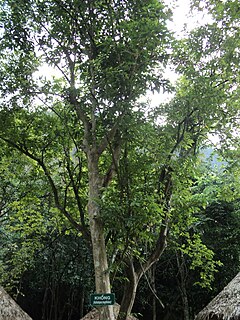
Koilodepas is a genus of plant of the family Euphorbiaceae first described as a genus in 1856. It is native to Southeast Asia, India, Hainan, and New Guinea.

Plukenetia is a genus of plant of the family Euphorbiaceae. It is widespread in tropical regions of Africa, the Indian Subcontinent, Southeast Asia, and the Americas.
Argomuellera is a genus of plant of the family Euphorbiaceae first described as a genus in 1894. It is native to sub-Saharan Africa, Madagascar, and the Comoros Islands.

Endospermum is a genus of plants, under the family Euphorbiaceae and the monotypic subtribe Endosperminae first described as a genus in 1861 It is native to E + S + SE Asia, Papuasia, Queensland, and certain islands of the W Pacific.
Alphandia is a plant genus of the family Euphorbiaceae first described as a genus in 1873. It is native to certain islands in the western Pacific.
- Alphandia furfuraceaBaill. - New Caledonia, Aneityum
- Alphandia resinosaBaill. - Art Island in New Caledonia
- Alphandia verniciflua Airy Shaw - West New Guinea
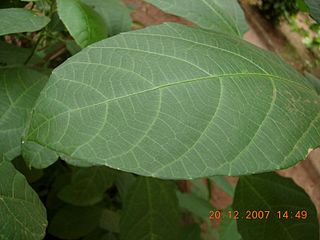
Baliospermum is a genus of plants under the family Euphorbiaceae first described as a genus in 1825. It is native to Southeast Asia and the Himalayas.

Homalanthus is a plant genus of the family Euphorbiaceae first described as a genus in 1824. It is the only genus in subtribe Carumbiinae. The genus is native to tropical Asia, Australia, and various islands in the Pacific.

Bridelia is a plant genus of the family Phyllanthaceae first described as a genus in 1806. It is widespread across Africa, Australia, southern Asia, and various islands of the Indian and Pacific Oceans.

Breynia is a plant genus in the family Phyllanthaceae, first described in 1776. It is native to Southeast Asia, China, the Indian Subcontinent, Papuasia, Australia, and the island of Réunion.

Daphniphyllum is the sole genus in the flowering plant family Daphniphyllaceae and was described as a genus in 1826. The genus includes evergreen shrubs and trees mainly native to east and southeast Asia, but also found in the Indian Subcontinent and New Guinea.
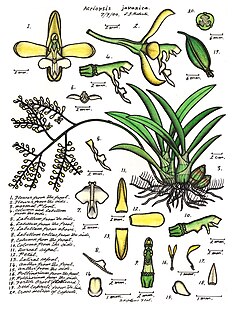
Acriopsis javanica is a species of orchid that is native to Southeast Asia, New Guinea, some Pacific islands and northern Australia. It is a clump-forming epiphyte with dark green leaves and curved, branching flower stems with many white and cream-coloured flowers with purple markings.
Exotheca is a genus of African and Southeast Asian plants in the grass family.

Peristylus, sometimes commonly known as ogre orchids or bog orchids is a genus of flowering plants from the orchid family, Orchidaceae. It consists of over 100 known species found across much of eastern and southern Asia as well as in Australia and on many islands of the Indian and Pacific Oceans.
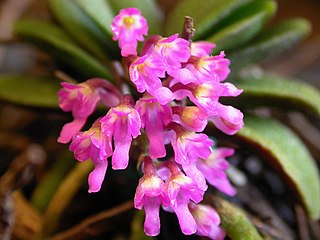
Schoenorchis, commonly known as flea orchids, or 匙唇兰属 , is a genus of flowering plants from the orchid family, Orchidaceae. Plants in this genus are small epiphytes with thin roots, thin leafy stems with leaves in two ranks and tiny fragrant, almost tube-shaped flowers with a prominently spurred labellum. There are about twenty five species found from tropical and subtropical Asia to the Western Pacific.
Melanolepsis multiglandulosa is a plant species of the family Euphorbiaceae, first described in 1826. It is native to Nansei-shoto, Mariana Islands, Solomon Islands, Bismarck Archipelago, New Guinea, Maluku, Sulawesi, Philippines, Lesser Sunda Islands, Java, Sumatra, Borneo, Thailand, Malaysia and Taiwan.














